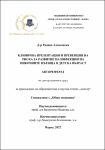I hereby declare that I will use the electronic library contents in compliance with COPYRIGHT AND RELATED RIGHTS ACT, Article 24, paragraph 1, item 9, only for scientific, cultural and educational purposes, without commercial gain, without commercial interest and non-profit.No Yes
Clinical Presentation and Risk Prevention of Developing Urinary Tract Infections in Childhood // Клинична презентация и превенция на риска за развитие на инфекции на пикочните пътища в детска възраст
Abstract
Диагностиката и контрола на ИПП на пръв поглед изглеждат лесна задача, но на практика остават най-спорни за решаване клинични въпроси в ПМП, това ни мотивира да потърсим причините. Изнесените данни в проучването разясняват основните фактори за най-честите затруднения свързани с ИПП в детска възраст. Липсва типична клинична картина на протичане, при кърмачетата и в ранна детска възраст. Допускат се грешки и изисква се време при вземане на урина за изследване и интерпретиране на резултата. ОПЛ предполагат ниска честота на разпространение на ИПП в детска възраст. Познаването на честотата на ИПП при различни подгрупи деца позволява на лекаря да оцени ориентировъчно вероятността от пикочна инфекция, навременно назначаване на изследване за потвърждаване на диагнозата. Понастоящем организацията на здравната система не позволява качествени прегледи, а смесването на здрави и заразно болни в чакалнята на ОПЛ поставя под риск здравите деца и води до страх и отказ от родителите за посещение на кабинета на ОПЛ. От друга страна ОПЛ не разполагат с достатъчно време при посещение по повод детска консултация да запознаят родителите с рисковете фактори за развитие на ИПП. Информираността на родителите и техните знания относно ИПП в детска възраст играят ключова роля в навременно поставена диагноза и предотвратяване на усложнения в зряла възраст. Diagnosing and controlling UTIs at first glance seem easy, but in practice, the most controversial clinical questions remain to be solved in Primary Healthcare; this motivates us to look for the causes. The data presented in the study elucidate the main factors for the most common difficulties related to UTI in childhood. There is no typical clinical picture in infants and in early childhood. Mistakes can happen, and collecting urine is a time-consuming process for examining and interpreting the result. GPs suggest a low prevalence of UTIs in childhood. Knowing the frequency of UTIs in different subgroups of children allows the physician to tentatively assess the likelihood of a urinary infection and make a timely appointment for an investigation to confirm the diagnosis. Currently, the organization of the health system does not allow qualitative examinations, and the mixing of healthy and infectious patients in the waiting room of the GP puts healthy children at risk and leads to fear and refusal of parents to visit the GP's office. On the other hand, GPs do not have enough time during a child consultation visit to inform parents of the risk factors for the development of UTI. Parental awareness and knowledge about UTI in childhood play a key role in the timely diagnosis and prevention of complications in adulthood.

